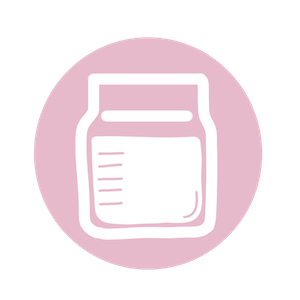Pumping and storing
Breastfeeding

If you are breastfeeding but will have to be away from your child during feeding time, you can express your breastmilk and store them for later use.
There are techniques you can use, but you have to plan it well to be able to prepare a sufficient stock of breastmilk for your child.
How to start pumping
One efficient way to start pumping immediately after nursing your baby. This tells the body to keep producing more milk, for stocking, even after your child finished feeding.
Another option is to trade one feeding session for a breast-pumping session and have your baby practice feeding from a bottle. You can try pumping a little longer than your baby’s normal feeding session.
How much and how long to pump
A basic and helpful rule for effective breast milk pumping is the supply and demand concept. The higher the demand for breastmilk, the more the supply — that is, your breasts will produce more milk when you pump more often.
Usually, babies require about 750-900 ml of milk per day, distributed among several feeding times. Therefore, you can generally follow the schedule of feeding your child every 2-3 hours for about 15 minutes per breast during daytime and pump at least twice at night, in case the supply goes low on the next day.
If you have to pump at work, pump once in the morning before leaving for work. While at the workplace, try to pump at the same time as your baby would normally feed — or every 3-4 hours. For better proficiency, one of the sessions during the day could be incorporated during your lunch hour. It will take about 15-20 minutes for each session while using a double electric breast pump.
Over time, it will be easy to decide which method fits best for each part of the day. But while you try to find your best approach, here are some guidelines that may help:
If you’re mainly breastfeeding:
- Pumping in the morning can be beneficial, as most mothers produce the most milk in the morning
- Pump 1 hour before or after your breastfeeding intervals as a backup to provide a sufficient amount for the baby
If you are only breast pumping:
- Plan to pump around 8-10 times per day
- Try to establish full milk production as time goes by — about 90-180 ml of milk per pumping session. Once you reach that amount, you can adjust the schedule whichever way you want, but be sure to have at least 750-900 ml ready for the baby each day
How to store breast milk
You should start planning how to store enough milk (about 750-900 ml per day) about 2 to 3 weeks before going back to work. Expressed milk should be stored in the freezer with a clear label indicating the production date. Older milk should be fed first.
If your milk supply from a session is not large enough to fill a bag, you can combine expressed milk from different sessions within the same day. Generally, the CDC recommends that frozen breast milk be consumed within 6 months.
How to use frozen milk
To properly thaw frozen milk, put the storage bag in warm water to let the milk slowly thaw. Thawed milk can stay in the refrigerator for up to 24 hours and should be thrown away within 2 hours at room temperature. Freshly expressed milk can last at room temperature for up to 4 hours and in the refrigerator for up to 4 days. NEVER refreeze leftover milk.
What you should know
If you find yourself unable to pump enough to keep a huge stock, don’t pressure yourself. What works for one mom doesn’t always work for another. What is important is that you do your best for your baby and yourself.
Verified:
Dr. Wanwadee Sapmee Panyakat (OB-GYN) (10 November 2021)



